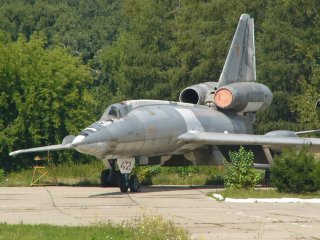Why Moscow is So Disappointed in Russia's Tu-22 Bomber
These bombers had many issues. Eventually, the Soviets improved the plane and made the venerable Tu-22M.
Here's What You Need to Remember: Ultimately the Tu-22 was succeeded by the Tu-22M. The Tu-22M is also supersonic, but is a variable-sweep aircraft that has superior handling characteristics, is more capable, and has friendlier pilot ergonomics. The Tu-22 probably wasn’t missed.
The Tu-22M proved itself as a capable bomber, but its predecessor—the ill-fated Tu-22—had a harder time. Here’s why.
First Supersonic Soviet Bomber
Though the Tu-22 had some characteristics that appeared to be beneficial, at least on paper, it was not pleasant to fly. It had two engines mounted above the fuselage near the tail assembly. The high placement of the engines complicated maintenance somewhat, as ground crews needed scaffolding to access the turbines.
The Tu-22’s wings were highly swept, which gave the jet good aerodynamic properties at transonic and supersonic speeds, but poor handling at subsonic speeds. It also had a long pointed nose, somewhat reminiscent of the Concorde supersonic airliner—and like Concorde pilots, Tu-22 pilots struggled to see the runway when landing.
The bomber required long take-offs to become airborne because of the low lift generated by the airframe’s highly swept wings. Also, landing was done at higher speeds than what pilots who transitioned to the Tu-22 from other aircraft were used to, which made landing a perilous operation for inexperienced pilots.
Early Tu-22s had a nasty tail strike tendency when taking off. The skin covering the airframe also tended to heat up during supersonic flight, which adversely affected the jet’s controls and flight characteristics.
Additionally, the Tu-22 had a unique seating arrangement. The pilot would be seated on the left, and the weapons officer slightly to the rear. The navigator sat below them, inside the plane’s fuselage. In case of emergency, the navigator would be ejected out the bottom of the jet.
Bombs Away
For defensive armaments, the Tu-22 had a single 23 millimeter auto cannon affixed to the tail. Since the weapons officer could not actually see where the cannon was pointing, a gun radar was used as an aiming assist.
In addition of an assortment of medium-sized unguided bombs, the Tu-22 could carry the massive FAB-9000 unguided bomb. As the name suggests, the FAB-9000 weighed 9,000 kilograms, or nearly 20,000 pounds and was packed with high explosives and created a massive explosion. FAB-9000s were used during the Iran-Iraq war, when Iraqi pilots used the massive bomb to hit Iranian cities.
Say Cheese
In addition to a bomb load, the Tu-22 could carry photography equipment and be used in an aerial photography role.
Tu-22s were used for photo-reconnaissance during the Soviet Union’s involvement in Afghanistan. Although the airframes and pilots had the necessary equipment and training for aerial reconnaissance, a combination of dusty and muddy conditions on local Afghani airfields hindered their aerial observation role.
Aftermath
Ultimately the Tu-22 was succeeded by the Tu-22M. The Tu-22M is also supersonic, but is a variable-sweep aircraft that has superior handling characteristics, is more capable, and has friendlier pilot ergonomics. The Tu-22 probably wasn’t missed.
Caleb Larson holds a Master of Public Policy degree from the Willy Brandt School of Public Policy. He lives in Berlin and writes on U.S. and Russian foreign and defense policy, German politics, and culture. This first appeared earlier this year and is being reposted due to reader interest.
Image: Wikimedia

